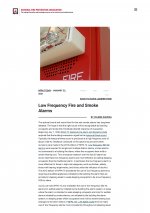I just had a service call for an elderly lady that had a problem with a light not working in one of her rooms. Wound up just being a on/off switch turned off on a wall paddle fan control she didn’t realize.
As I am talking with her a notice a series of beeps coming from somewhere, I asked what it was and she says she doesn’t hear anything. Well, I find it to be a carbon monoxide alarm chirping like a low battery. I have it in my hand right in front of her and it chirps 3 times. I ask if she heard that and she said no.
I proceed over to her piano and rattle a few notes around middle c and she says she hears that but when I go to the highest octave she did not hear those notes. So I hit the test button on the smoke alarm again she does not hear it.
So, now I’m thinking NFPA should come up with something with varying frequencies so people with hearing loss (which usually starts out with certain frequency ranges) aren’t left with smoke detectors they can’t even hear.


